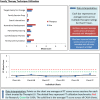Measurement Training and Feedback System for Implementation of family-based services for adolescent substance use: protocol for a cluster randomized trial of two implementation strategies
- PMID: 30866967
- PMCID: PMC6416843
- DOI: 10.1186/s13012-019-0874-6
Measurement Training and Feedback System for Implementation of family-based services for adolescent substance use: protocol for a cluster randomized trial of two implementation strategies
Abstract
Background: This article describes a study protocol for testing the Measurement Training and Feedback System for Implementation (MTFS-I) and comparing two implementation strategies for MTFS-I delivery. MTFS-I is a web-based treatment quality improvement system designed to increase the delivery of evidence-based interventions for behavioral health problems in routine care settings. This version of MTFS-I focuses on family-based services (FBS) for adolescent substance use. FBS, comprising both family participation in treatment and family therapy technique use, have achieved the strongest evidence base for adolescent substance use and are a prime candidate for upgrading treatment quality in outpatient care. For FBS to fulfill their potential for widespread dissemination, FBS implementation must be bolstered by effective quality procedures that support sustainable delivery in usual care.
Methods/design: Adapted from measurement feedback systems for client outcomes, MTFS-I contains three synergistic components: (a) weekly reporter training modules to instruct therapists in reliable post-session self-reporting on FBS utilization; (b) weekly mock session videos of FBS interventions (5-8 min) for supportive training in, and practice coding of, high-quality FBS; and (c) monthly feedback reports to therapists and supervisors displaying aggregated data on therapist-reported FBS use. MTFS-I is hosted online and requires approximately 20 min per week to complete. The study will experimentally compare two well-established implementation strategies designed to foster ongoing MTFS-I usage: Core Training, consisting of two 3-h training sessions focused on FBS site mapping, selecting FBS improvement goals, and sustaining MTFS-I, followed by routine remote technical assistance; and Core + Facilitation, which boosts Core Training sessions with collaborative phone-based clinical consultation and on-site facilitation meetings for 1 year to promote FBS goal achievement. The study design is a cluster randomized trial testing Core Training versus Core + Facilitation in ten substance use treatment clinics. Study aims will compare conditions on MTFS-I uptake, FBS delivery (based on therapist-report and observational data), and 1-year client outcomes.
Discussion: Study contributions to implementation science and considerations of MTFS-I sustainability are discussed.
Trial registration: ClinicalTrials.gov NCT03342872 . Registered 10 November 2017.
Keywords: Adolescent substance use treatment; Cluster randomized implementation trial; Facilitation; Family-based services; Measurement feedback system; Quality improvement.
Conflict of interest statement
Ethics approval and consent to participate
Study activities have been approved by the governing Institutional Review Board.
Consent for publication
Not applicable.
Competing interests
The authors declare that they have no competing interests.
Publisher’s Note
Springer Nature remains neutral with regard to jurisdictional claims in published maps and institutional affiliations.
Figures
References
-
- Institute of Medicine. Improving the quality of health care for mental and substance-use conditions. In: Quality chasm series. Washington, DC: Institute of Medicine; 2006.
-
- Institute of Medicine . Psychosocial interventions for mental and substance use disorders: a framework for establishing evidence-based standards. Washington, DC: The National Academies Press; 2015. - PubMed
-
- The National Center on Addiction and Substance Abuse . Adolescent substance use: America’s #1 public health problem. New York: The National Center on Addiction and Substance Abuse; 2011.




